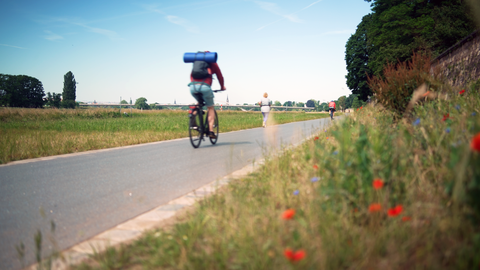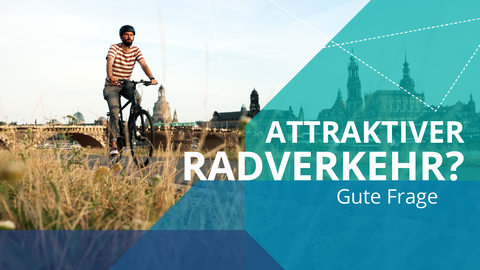Sep 18, 2024
How can we make cycling safer and more appealing? “Gute Frage” (Good Question) on cycling research at TU Dresden
Riding a bicycle is good for the environment and good for your health. But if we want to encourage the use of bikes, they need to be more comfortable and less dangerous. Researchers at TU Dresden are investigating what good cycling infrastructure looks like and what measures can be taken to make it safer for cyclists.
In the German cities of Münster and Oldenburg, more than 40 percent of all trips under 30 kilometers are made by bicycle. “This demonstrates the enormous potential bikes have in cities,” explains Professor Regine Gerike as part of our ‘Good Question’ series. “Most of the travel we do is within our local area, and bicycles are ideal for this.” In addition to being associated with significantly lower greenhouse gas emissions than motorized transportation, bicycles are often faster than cars for short trips. And cycling has an additional advantage, says the traffic scientist, “it enables us to use space more effectively. If we get more people cycling, we can redistribute the use of space and create more recreation areas, make urban areas cooler, or create more drainage systems."
How can we make cycling safer and more popular? Good question on cycling © TU Dresden video team
Bicycle highways, smooth road surfaces, and bridging the gaps: What makes for good cycling infrastructure?
If we want to get more people cycling, we need to create the right conditions. TU Dresden is researching what good cycling infrastructure looks like, using data obtained from the CITY CYCLING campaign. As part of the initiative, which is currently running in Dresden until September 27, cyclists use an app to record their daily routes for 21 days. Sven Lißner and Stefan Huber from the Chair of Transport Ecology will analyze this data for their research projects. “We know that cyclists need well-developed cycling infrastructure. They prefer smooth road surfaces and would like to see a good network of bike lanes with fewer gaps,” says Stefan Huber. The construction of bicycle highways is also an important factor.

New Körnerweg cycle path on the banks of the Elbe
A good example is Dresden’s Körnerweg, a road that follows the Elbe river between the Saloppe beer garden and Blaues Wunder bridge. This historic towpath – paved with sandstone cobbles with large gaps – was temporarily surfaced with asphalt during construction work, and this also had an impact on bicycle traffic. “This route was hardly used before, and now it’s an appealing alternative to the Elbe cycle route on the other side of the river,” explains Sven Lißner. “It just shows what’s possible.” There is now a new cycle path parallel to the old path. To better identify needs and support service-planning by cities and municipalities, transport scientists at TU Dresden are developing a bicycle simulation. While there are already good simulations for cars, there is no such tool for bikes. “This will enable us to assess measures and effects in the future and to prioritize expansion projects,” explains Stefan Huber.
Safety when cycling: How can conflicts in road traffic be reduced?
In addition to inadequate infrastructure, concerns about safety also prevent people from cycling more often. “Cycling is not dangerous in and of itself. It only becomes so due to interaction with other road users – especially cars,” says Sebastian Hantschel, who researches road safety in cycling and pedestrian traffic at the Chair of Mobility System Planning. “The aim is to minimize the number and intensity of conflicts between road users.” Sebastian Hantschel adds that the number can be reduced through separate and, ideally, segregated cycling infrastructure. In places where this is not possible, however, lower speed limits could reduce the risk and severity of accidents. “When the traffic flow is more homogeneous, there are fewer conflicts.”

Danger for cyclists: Right turning cars
Bicycle accidents typically occur at intersections, especially with cars turning right, vehicles entering and exiting parking spaces, and along tram tracks. “The ultimate cycling infrastructure,” adds Stefan Huber on the subject of safety, “is wide cycle paths that are protected from other traffic. That's how we get more people on bikes.” This in turn contributes to safety. “If more people are cycling, the risk to individuals decreases,” explains Sebastian Hantschel. This is the safety in numbers effect, which indicates that cyclists in large groups are less likely to be involved in an accident than those traveling alone.
Safe, fast, and comfortable: How to make cycling more appealing
“Cycling must be safe, fast, and comfortable,” summarizes Stefan Huber. Well-developed and, above all, safe cycle paths ensure that cycling is an appealing alternative to other modes of transport. “Cycling is an important cornerstone of climate protection in everyday travel,” says transport scientist Regine Gerike. Research using CITY CYCLING data will form a basis for making decisions on bicycle-friendly urban planning.
TU Dresden researchers provide a more in-depth look into their research on cycling infrastructure and safety in the latest episode of “Gute Frage” (Good Question) on the “TU Dresden entdecken” (Discover TU Dresden) YouTube channel. The Dresden Transport Museum also takes a look at the history and historical significance of the bicycle. The ePredikt research project, which investigates fatigue behavior of certain e-bike components, is also presented in the video.
Contacts:
Prof. Regine Gerike
Chair of Mobility System Planning
Dr. Sebastian Hantschel
Chair of Mobility System Planning

